In women’s football, Spain have not won any major competition despite having good development for many years with strong individuals. In the last EURO, they could not beat England and lost the game in extra time, and it was reported that as many as 15 players were not happy with the process in the national team and requested not to be selected.
But the RFEF did not back off. Instead, they put the info to the public and announced that the “las 15” would be penalised; many of them were not included in the national team for some time, though some returned before this tournament. This tactical analysis aims at explaining the tactics of Jorge Vilda with both data models and analysis of their performance in the games.
Predicted starting XI
Over the past ten months, Vilda has had to experiment a lot with his team because some players have been quite new to the international level and he has been missing some of his key players. Except for the conventional 4-1-2-3 formation he used, there were plenty of occasions he lined up his side in a 3-4-1-2 to see if a back three formation could work better. We believe that the back four would still be the primary option, especially when they have to attack more in the group stage, but the variation could serve as an alternative in knockout stages or even in the match with Japan when Spain wanted to put focus on their defence.
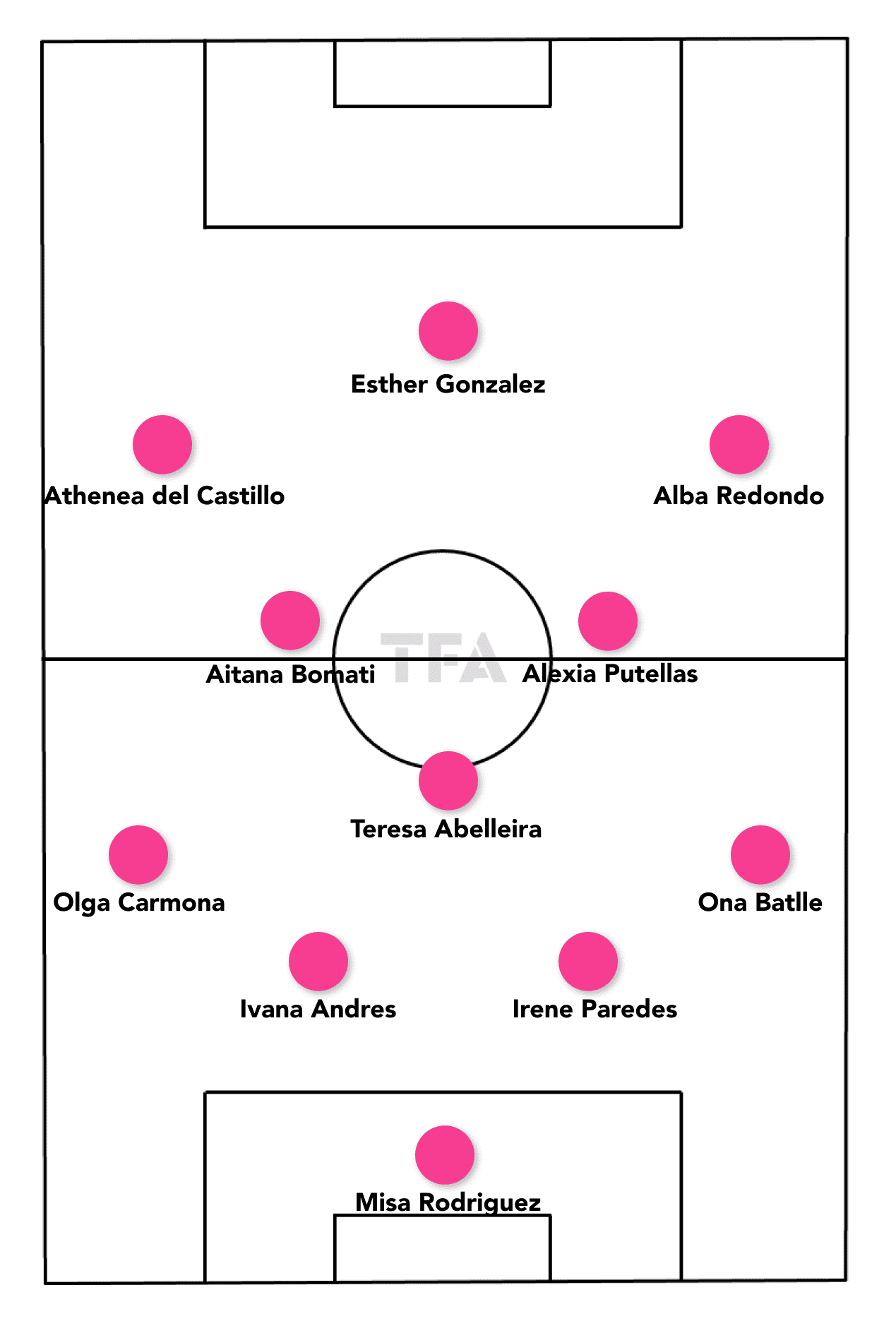
Under the 4-1-2-3 of Vilda, it was a difficult task to predict the starting XI because the list he gave included players who did not play in the past year, so they could have more changes than the picture above. Misa Rodríguez earned her place in the year Sandra Paños was not in the team, and Vilda trusted her to be the No.1; it is a settled position. In the back four, although Athletic Club’s Oihane Hernández played some games in friendlies, Ona Batlle will probably be back at right-back. The Spain women’s team now has plenty of Real Madrid players. Olga Carmona will be the starting left-back, with her partner at the club, Ivana Andrés, as the centre-back. Then, it could be Irene Paredes who came back to strengthen the defence at the expense of Rocío Gálvez.
In midfield, Teresa Abelleira provided decent performance in friendly games and she could be a good holding midfielder to support the team. Vilda has had so many options in these positions. Alexia Putellas could come back from injury, although we are not sure if she will jump straight to the starting XI, as well as her FC Barcelona teammate Aitana Bonmati (the coach has been giving ambiguous answers in the press conference). But Spain have also had very good quality players such as Jennifer Hermoso of Atlético Madrid, Claudia Zornoza, and Maite Oroz in these positions, so they could come out with a 4-2-3-1 as well.
The front three will be Esther González, Athenea del Castillo and Alba Redondo — all of whom are players Vilda has trusted over the past year. González should take the striker position; on the flanks, they could also try Salma Paralluelo or other options.
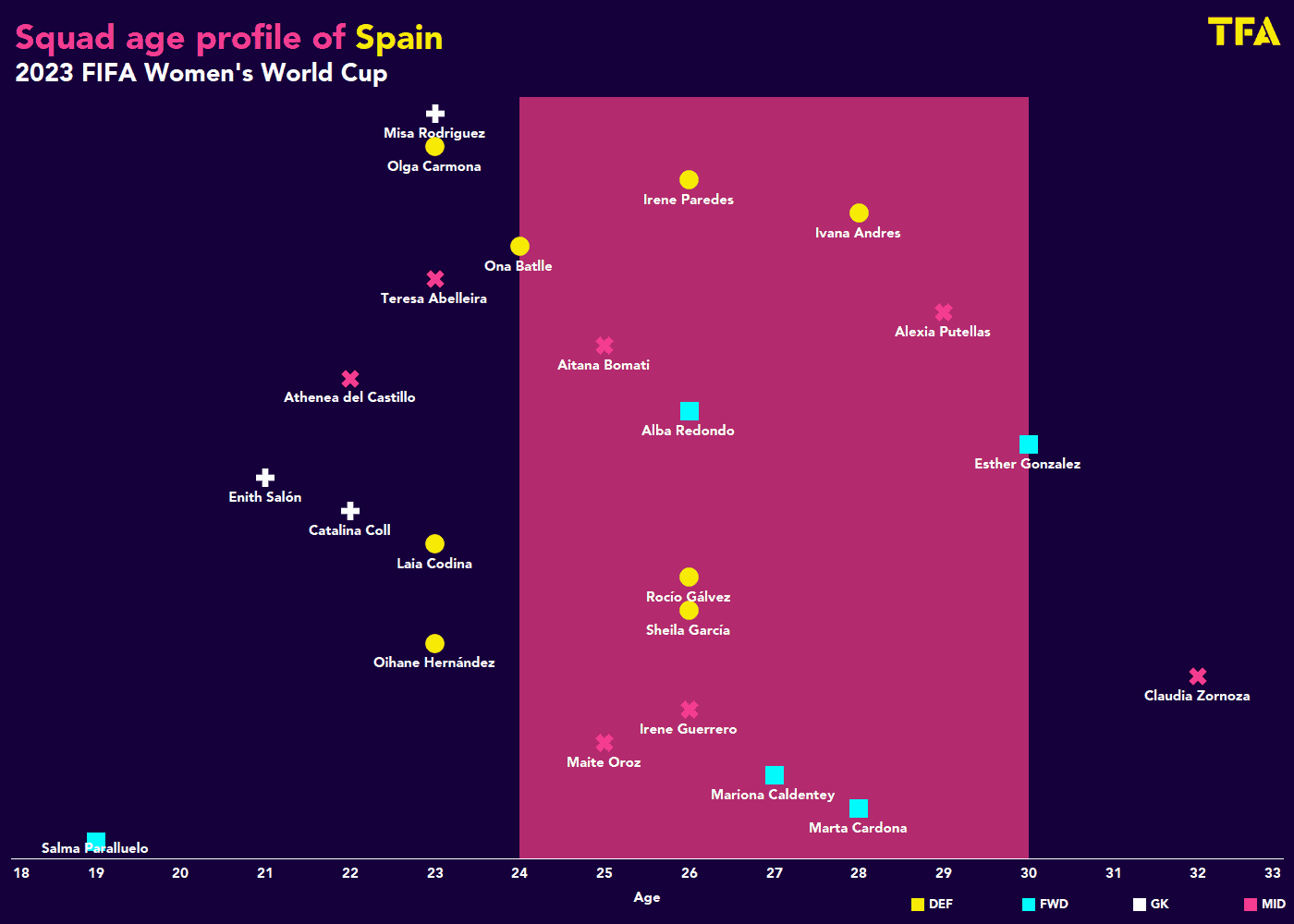
Most of Spain’s key players are at their prime right now. Even the oldest player – Zornoza — is only 32. The likes of González, Alexia Putellas, Andrés, and Paredes, are at a good age with decent experience both domestically and internationally. Then, Vilda also has plenty of hungry youngsters such as Paralluelo and Athenea, who could take further steps in their national team careers.
Attacking phase
Offensively, Spain are a side with a very similar playing style to the men’s team, and this is probably something we would expect from Spanish football. They tried to play positionally and follow the game plans of the coach to a large extent, with a clear division of spaces and roles on the pitch. This section will analyse how they play in the offensive moments.
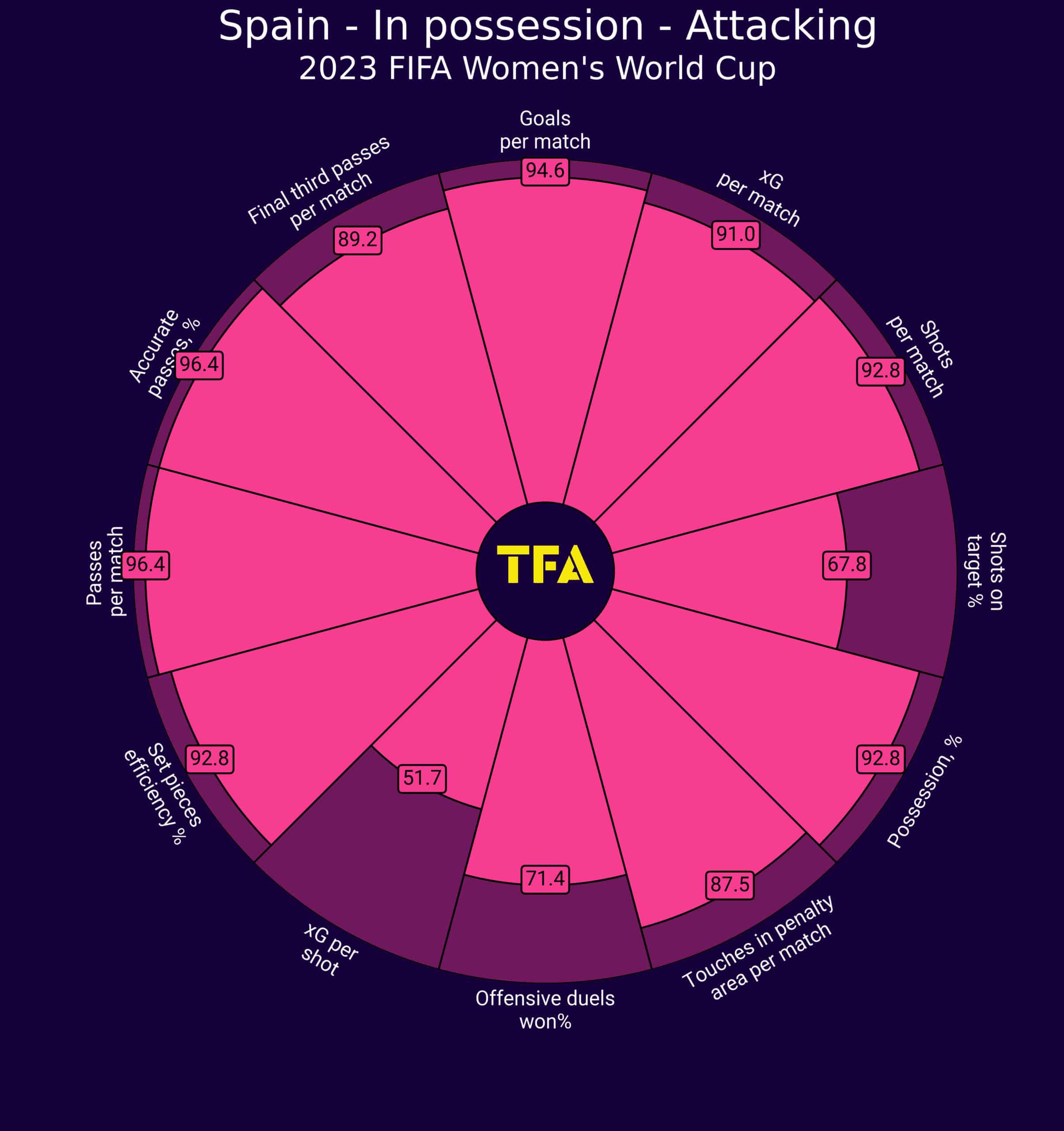
We can already have a good picture of the playing style of Spain with this chart. They are a team that tries to play on the front foot with good ways to enter the last third, as their percentile ranked 89.2 at final third passes per match would indicate.
All the metrics above have suggested they attack a lot, dominating possession at 92.8 percentile rank while having 87.5 percentile rank at touches in penalty area per match. With 91.0 percentile xG per match, they create a lot of chances, while shots per match percentile at 92.8 and goals per match percentile at 94.6 also suggest we should expect Spain to threaten a lot at the business end of the pitch.
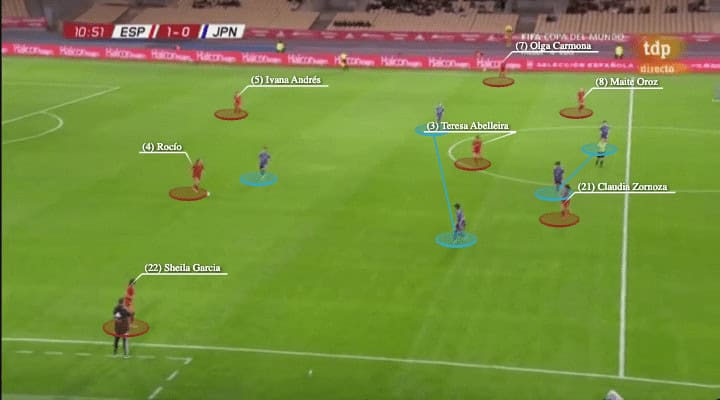
As we suggested, they’re a side that prefer playing positionally and according to the game plan of Vilda strictly. The players do not have much freedom, especially when the team try to open themselves to occupy different zones on the pitch; you will see them playing in a strict 4-1-2-3 in principle and adding up a few variations. To a large extent, they use the positions of players to define functions.
For example, the first example has shown Spain building up with a back four, full-backs occupying the width as suggested by Sheila Garcia and Carmona’s positions. But there is also a hint that Carmona could enjoy some freedom to push high and wide as she was good in the attack, and when that happens, the left-winger should go inside because the team has strict positional demands such as the winger and full-back being in alternative vertical lanes. Of course, this would arguably not suit all players, Athenea would be more or less caged in her position and feel less comfortable in her offensive actions, but we will see how Spain develop these tactics during the tournament.
In addition, when Carmona pushes forward, Spain could have the ‘number 8’ dropping out to receive and take that space. That role would be Oroz in the image we suggested, although they could also keep Putellas higher in other cases. This image also outlines the disciplined Spain midfield space occupation because they hold a triangle inside the central three zones, including both half-spaces. This would be largely similar to what we saw with the men’s team in the FIFA World Cup 2022 in Qatar when Pedri and Gavi started with Sergio Busquets.
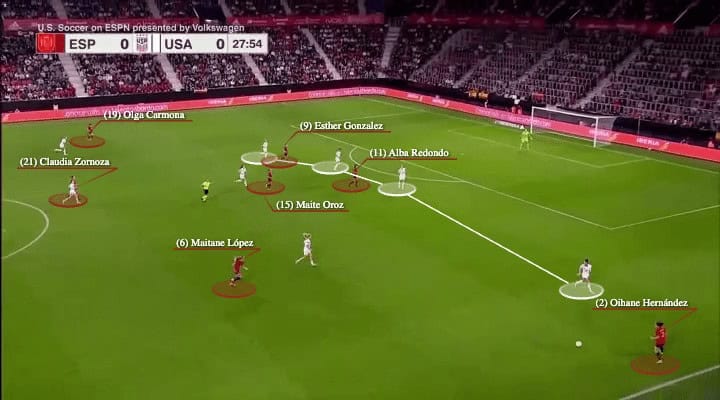
Here, in the second image, we see Spain’s alternative formation (3-4-1-2) as they use this against stronger opponents. They were playing the United States in this situation. Despite the change of formations, they still showed many features similar to the back four, such as the wide players (Carmona & Hernández) holding width strictly on the sides. Again, the wide players would be important because Spain are a team that try to shift the ball to the side and attack from there.
Then, in midfield, we see the triangle again. Occupying the key zones in the centre, as we noted, are Zornoza, Maitane López, and Oroz. Up top will be a pair of attacking players, Redondo and González — and these two could also appear on the side. So far, it seems as though Vilda trusts these two players in this position more than Athenea, but let’s see how he will tweak his approach once he has other options in the main tournament.
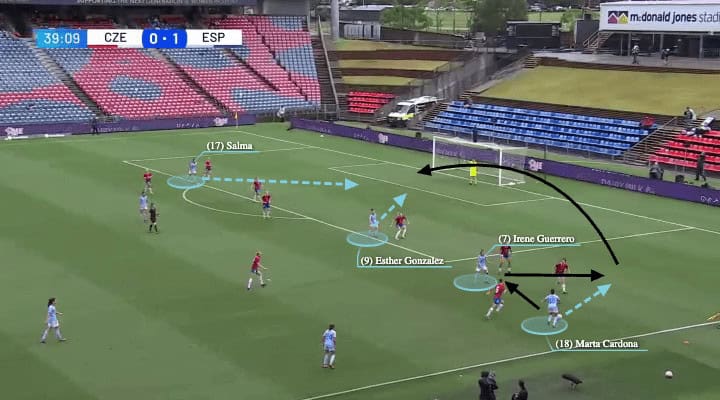
By nature, in the friendly games, Carmona’s side had better ability to drive with the ball with Athenea, and the pair enjoyed running towards the opponents, while the threat from the right flank was more direct, and the crosses were coming earlier. There were also possibilities of adding González on the side to imbalance the defence and finish with players arriving from the far side.
It’s important that we mention how Spain attack from the flanks because most of their opportunities come from crosses. Again, we can see clear ideas of playing. Here, Marta Cardona made a one-two with Irene Guerrero, then put in a cross to finish. The way they attacked the goal was usually González with a winger from the far side. The run from the opposite flank would be quite crucial as González showed a tendency to drift nearer to the ball, so she was more likely on the first post when the defenders were dislocated. They free up the space on the second post.
Defensive phase
Defensively, Spain might have some concerns despite having decent records in the last year. They are not very drilled in their defensive style of play and do not have a good way of pressing. This would be even more difficult when Vilda had to add up players who did not play for a long time into the team.
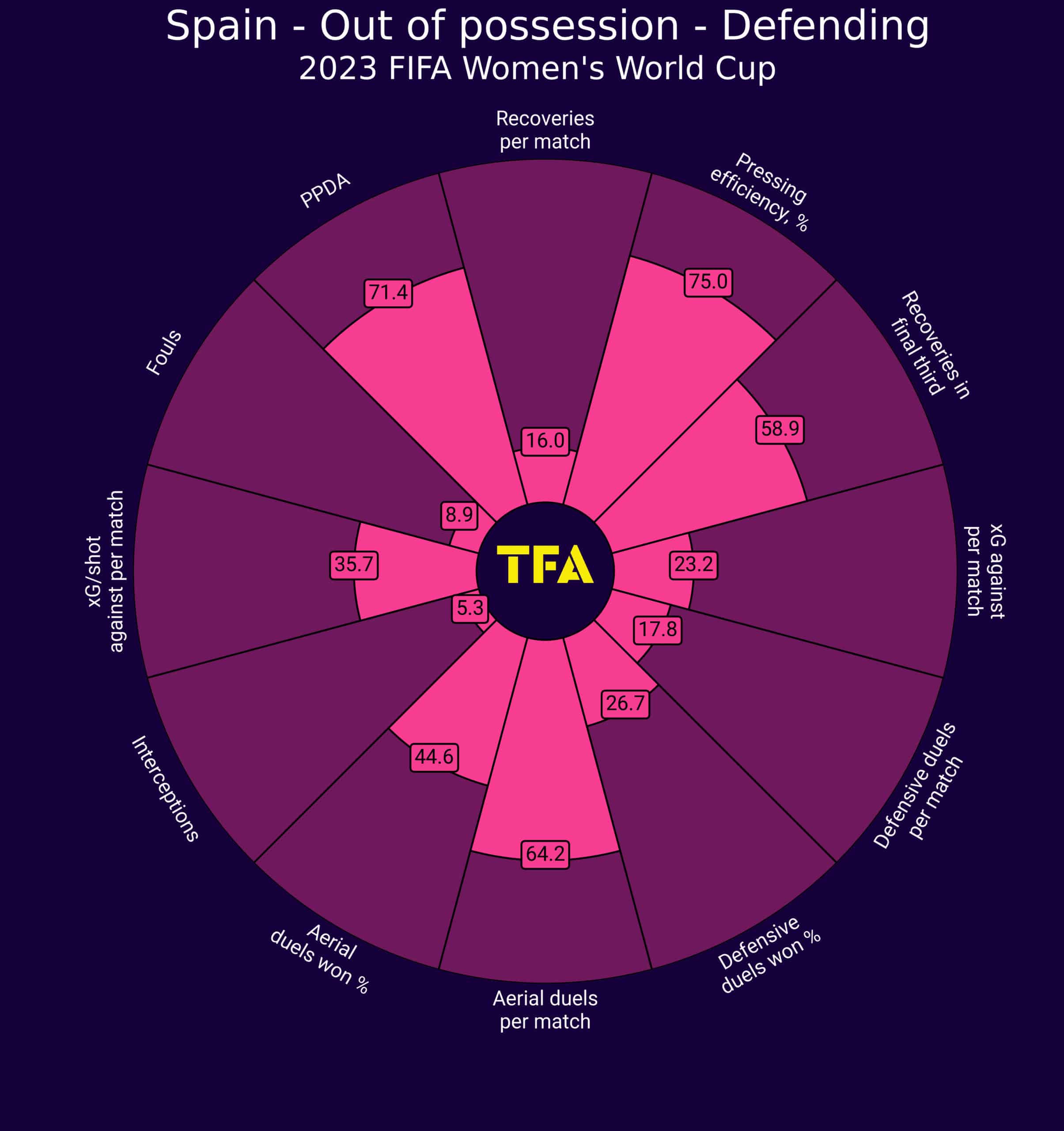
Spain are not very strong in pressing when they do not possess the ball. With a high PPDA percentile rank of 71.4, the defensive numbers were not too good in several aspects of the game. The problem is indicated in their low defensive duels per match percentile ranking of 17.8. We could explain that as a result of their having more possession and attacking more, but if we checked the defensive duels won% percentile, at 26.7, was very poor, and it reflects they were not good at stopping the opponent in individual battles; we were going to show why in the analysis below.
In general, Spain had an average ability to win the ball back in both high areas and around their third, as their recoveries in the final third were only at 58.9, and recoveries per match percentile were also at a really low ranking at 16.0. When it comes to preventing the opponent from generating goal chances, Spain had a decent percentile ranking at 23.2 xG against per match.
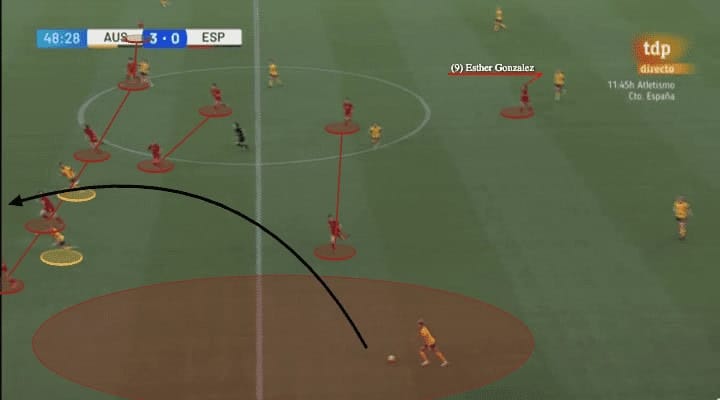
One of Spain’s biggest problems was their inability to find the moment to push. They do not do high press, especially against a stronger opponent. Vilda’s side were more settled at defending in the midfield areas in formations similar to how they lined up on paper.
But there were many issues. Regardless of formation, back three or back four, they could not control the space properly because they were not pressuring the opponent. For example, González, the striker, always jumped solo on the opponent centre-backs as they did not organise moments to go together. Then she was bypassed easily, and the pressure was usually ineffective.
They were also usually without cover too. Here, we see how Australia easily sent the ball to wide space when Spain were defending in a 5-2-2-1, and the space was too big for the two-player midfield chain to shift across. Then, the wide defenders were not aggressive to step up to close the wide space – although they were good in this regard, the whole defensive line thought about the ball behind too much. Then they had some occasions facing the opponents in front of their penalty zone as a result of how they behaved without possession.
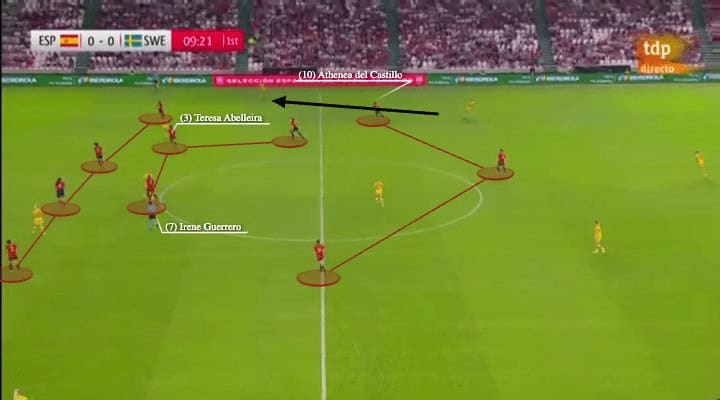
Here, we have another example, as we have shown from the Sweden match, although Spain were defending with a back four. It was a 4-2-1-3 or 4-1-2-3, and the problem was the front three’s narrow position without effective pressure on the opponent — the wide space would always be exploited by simple passes. Here, because of Athenea’s inside position, Sweden easily sent the ball to the side, and usually, it would be hard for the full-back to read the moment to jump.
In the centre, Vilda preferred the ball-far ‘8’ dropping next to the holding midfielder so that Abelleira could always be closer to the ball on the ball side to cover, but the control of spacing is also a big issue of the team that has to be dealt with. Spain’s midfield was very exposed in some matches when both jumped together. This was a problem because of how they were disorganised in the high-pressure moments. Spain could easily become passive and just let the opponent attack in their midfield defence, hence, losing control of the game.
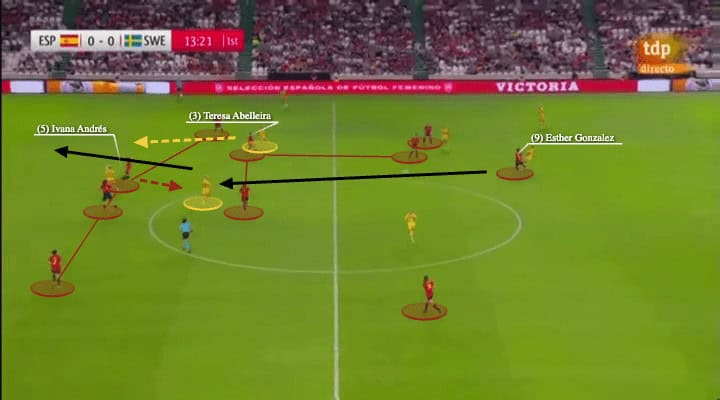
This was how they conceded a goal to Sweden, and it summed up all the features we have explained above. Firstly, it came from González’s ineffective pressure as her position would not put the opponent’s defender in difficulties. Then, the opponent easily found spaces behind and between the midfielders as Abelleira was marking the support wider as the tactics demanded her to do so. But Spain’s central defender, Ivana, was not too precise and consistent when she had to come out and close space; the best teams in the world could take advantage of this and do harm, as we saw Sweden develop into a chance with runs behind following their break of the lines.
Transitions
How Spain manage the transition phases is also a big problem, as they have clear weaknesses in possession. In the last tournament, they conceded a goal to England in extra time as Georgia Stanway scored a long shot. If Spain managed to improve the transition from attack to defence well, they would have a bigger chance to reach further stages of the tournament.
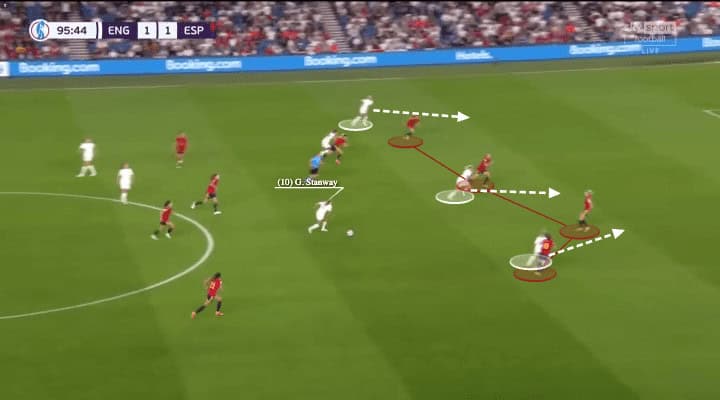
Here, we observe the situation before Stanway’s goal again. Spain’s last line tried their best to come narrow and close the gap, also hoping to delay the threat when they stopped the run behind. But top players have the necessary quality to punish, as Stanway took the chance to shoot when the defenders did not pressure her. That could be a result of lacking cohesion in how Spain set up possession.
Usually, they find each other at larger-than-ideal distances as they need to occupy certain spaces, and therefore longer-range passes are made, which gives the opponents more time to read and intercept. Furthermore, some players are less capable of solving the situation when they’re alone and confronted with pressure. Along with some technical mistakes, Spain could actually concede a lot of turnovers in the build-up and therefore concede chances.
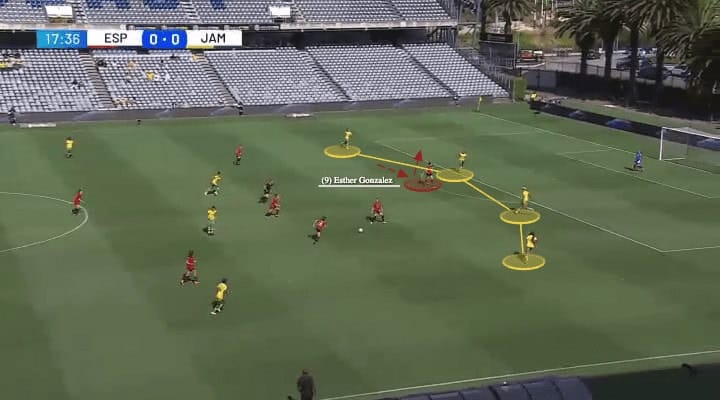
While in offensive transitions, Spain have the qualities of Athenea to dribble and take on the opponents. They would be happy to keep possession. Against weaker teams that Spain could attack more, they should force turnovers in the higher part of the pitch.
It could be largely about the striker’s quality to read the game and make the runs. González was good at this, as we are showing in this example. She initially wanted to go behind after coming outside-in, but noted that Jamaica’s defence was narrowing and the central defender was coming in. She instead moved diagonally out again to see if she could set herself in the best channel. It shows that González is a good player who constantly tries to adapt, and she also had good finishing in these moments too.
Attackers
Spain have several viable attacking options. Athenea will be one of the wingers who could provide a direct threat to the opponent. She is good on the ball and has a good desire to take on opponents, with 11.16 dribbler per 90 in the UEFA Champions League this season and two goals in her last three international appearances. Meanwhile, her teammate at the club, Esther, once scored four goals in a match against Strum Graz and scored seven goals from 5.34 xG for her country.
Midfielders
In midfield, Putellas has returned, but we do not know if she can start an intense game yet. But Spain had other good options. Bonmati had a great season with three assists in the UEFA Champions League; she also had a high defensive duels win rate at 80%. Alongside Abelleira, who averaged 13.48 passes to the penalty area for her country in the past year, will be one of the main players to construct an attack.
Defenders
Andrés has very strong defensive numbers when playing for her country, with 10.16 recoveries per 90, 5.13 defensive duels per 90, and a win rate was 75.5%. We expect her to be a key defender to stop the opponent’s attack. Meanwhile, Carmona averaged 5.38 crosses per 90, 4.76 dribbles per 90, and 2.9 progressive runs in the national team. These numbers suggest that she has a high involvement when her team is attacking.
Key player
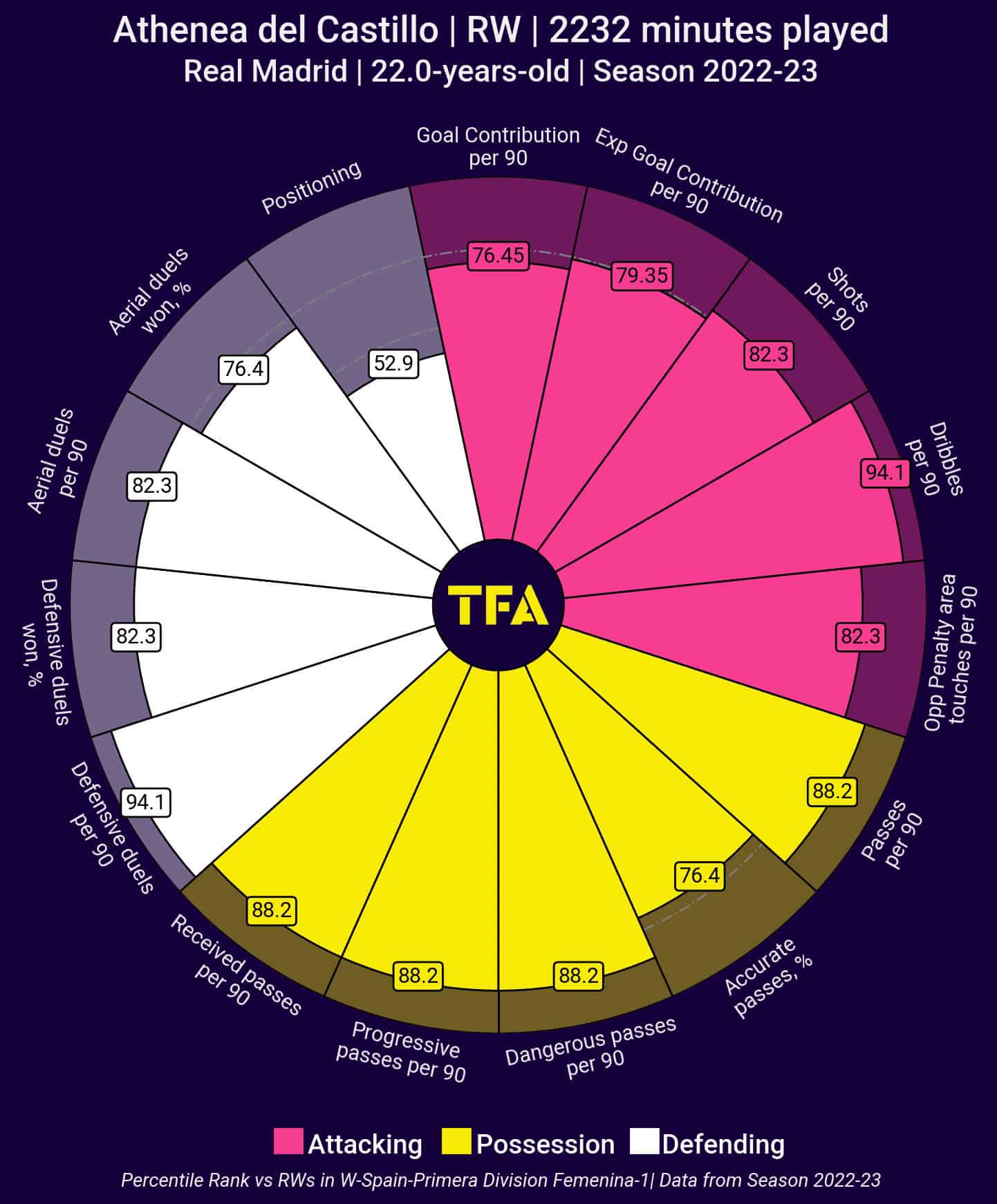
Spain have a lot of quality players; the biggest star must be Putellas, who came back from injury and won another UEFA Champions League with Barcelona. So we are picking another player that we could expect something from: Athenea of Real Madrid. She’s young, at 22, but this is not her first major competition. She was also in Vilda’s squad after impressing everyone at the club level and continental levels.
And Athenea is a very well-rounded attacker, with high shots per 90 percentile at 82.3, incredible on the ball as her dribbling per 90 percentile was 94.1, and also penetrative threats with 82.3 percentile ranking at opp. penalty area touches per 90.
She is also hardworking defensively, with defensive duels per 90 percentile ranking at 94.1. This shows she always came back to defend with her full-back. The question that remains is the degree of freedom to give her because now she is more caged by her position. If she had the chance to express herself even more, Spain could attack with even better dynamics — and it would be harder for the opponent to defend.
Tournament prediction
On paper, Spain could be one of the strongest sides in the world and possibly be categorised in Sweden, Japan, and the United States level. They had decent results since the EURO disappointment even though some key players missed out on the squad, but as we explained, there were concerns tactically and also other issues as this scout report has suggested.
We don’t exactly know how much Putellas can play, and there could also be the risk of bad chemistry because some in the group have not played together that much. Hence, it is not only the tactical part Vilda has to solve but also management issues he has to face and address in order to make this team great. It should not be too difficult for Spain to progress to the quarter-final with the quality they possess, but how far they could go really depends on the small stuff, as the margin could be very tight in games against stronger opponents.

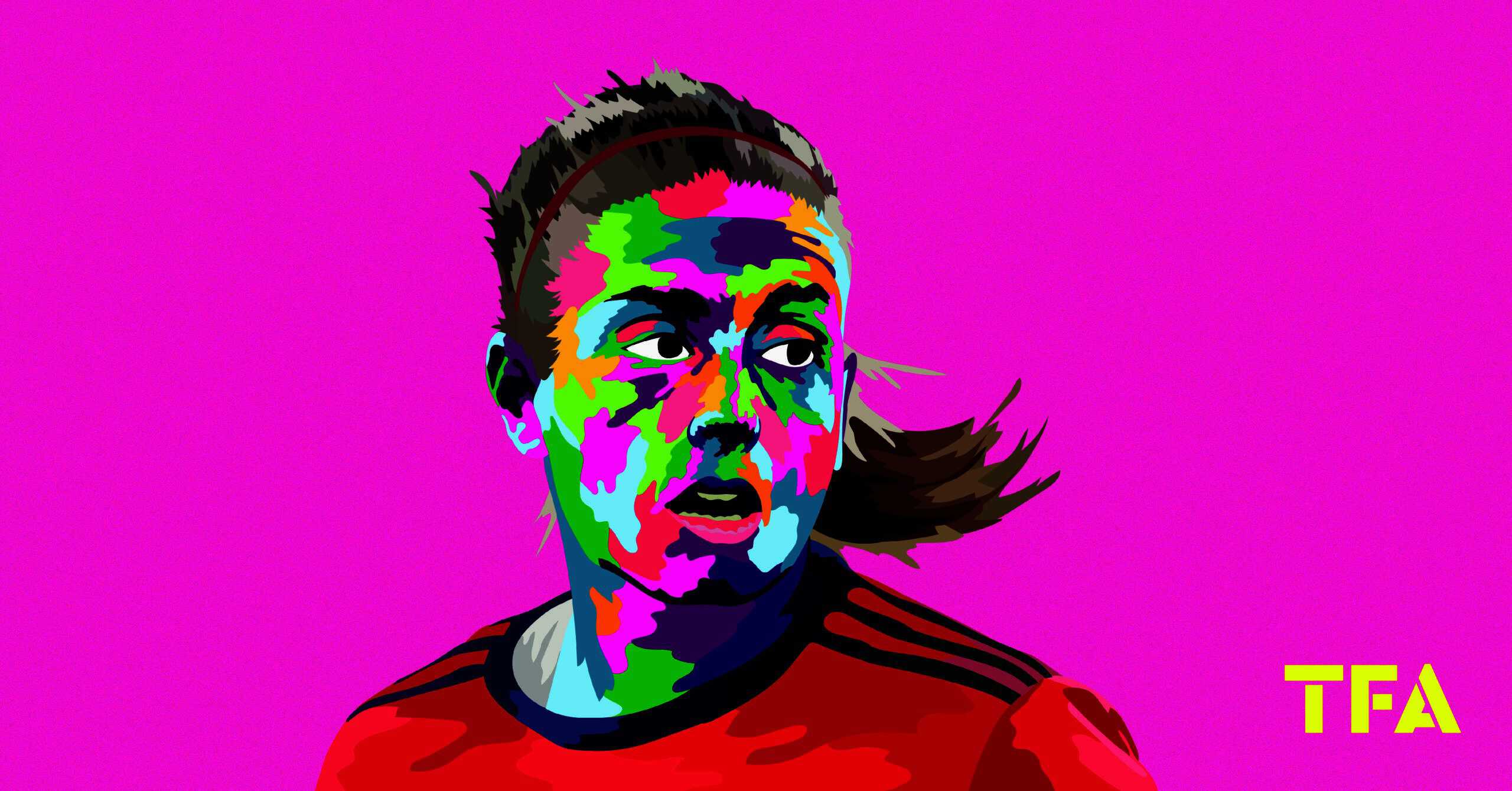



Comments